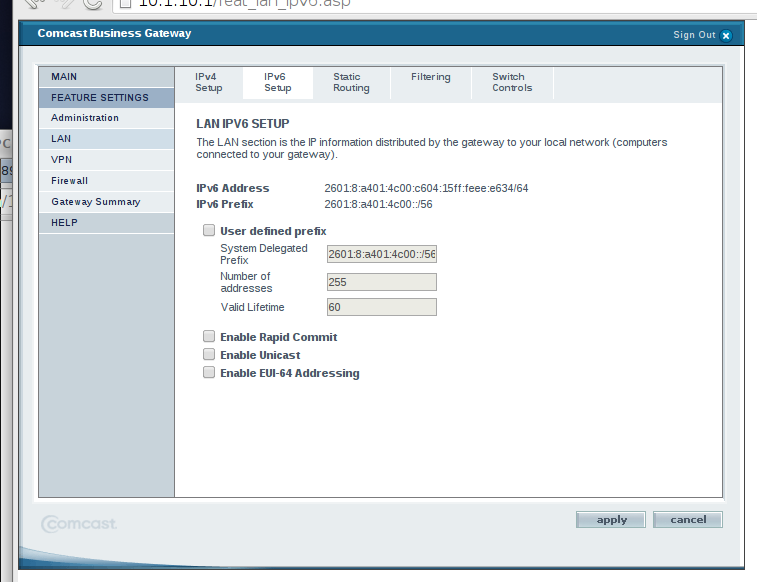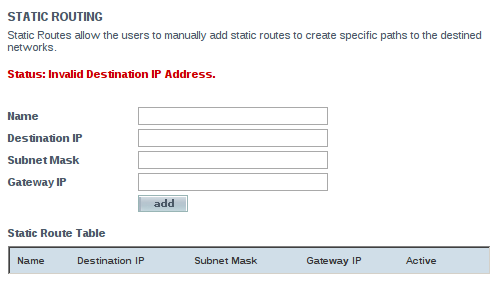
 |
| News | Profile | Code | Photography | Looking Glass | Projects | System Statistics | Uncategorized |
Blog |
Comcast Business decided to give me some IPv6 lovin' a week or two ago on my DOCSIS connection. Unfortunately, it still seems to be a work in progress.

The above is the IPv6 configuration screen on my (well, Comcast Business') NETGEAR CG3000DCR. I've got a /56 that I suspect was obtained via DHCPv6-PD on the DOCSIS interface. The LAN interface has a /64 out of that /56 and supports DHCPv6-PD as well. It's also got RAs enabled with RDNSS:
21:08:16.491207 IP6 (hlim 255, next-header ICMPv6 (58) payload length: 120) fe80::c604:15ff:febe:e634 > ff02::1: [icmp6 sum ok] ICMP6, router advertisement, length 120 hop limit 64, Flags [other stateful], pref medium, router lifetime 1800s, reachable time 0s, retrans time 0s source link-address option (1), length 8 (1): c4:04:15:be:e6:34 0x0000: c404 15be e634 prefix info option (3), length 32 (4): 2601:8:a401:4c00::/64, Flags [onlink, auto], valid time 345600s, pref. time 345600s 0x0000: 40c0 0005 4600 0005 4600 0000 0000 2601 0x0010: 0008 a401 4c00 0000 0000 0000 0000 unknown option (24), length 24 (3): 0x0000: 3800 0005 4600 2601 0008 a401 4c00 0000 0x0010: 0000 0000 0000 rdnss option (25), length 40 (5): lifetime 60s, addr: 2001:558:feed::1 addr: 2001:558:feed::2 0x0000: 0000 0000 003c 2001 0558 feed 0000 0000 0x0010: 0000 0000 0001 2001 0558 feed 0000 0000 0x0020: 0000 0000 0002
The RDNSS allows IPv6 clients that have not yet embraced DHCPv6 to mostly work without IPv4, which is nice (although I still think it's a hack).
I was puzzled by the other options on the configuration screen, though. The "Enable Unicast" and "Enable Rapid Commit" initially meant nothing to me and I assumed the "Enable EUI-64 Addressing" toggled the "A" flag in the RA. I individually toggled all of the options and compared the results, which required a few reboots, unfortunately. From what I can tell the "Enable Rapid Commit" and "Enable EUI-64 Addressing" options do absolutely nothing to the RA messages. However, "Enable Unicast" removes all the flags and all but one option in the RA:
20:59:52.178671 IP6 (hlim 255, next-header ICMPv6 (58) payload length: 24) fe80::c604:15ff:febe:e634 > ff02::1: [icmp6 sum ok] ICMP6, router advertisement, length 24
hop limit 64, Flags [none], pref medium, router lifetime 0s, reachable time 0s, retrans time 0s
source link-address option (1), length 8 (1): c4:04:15:be:e6:34
0x0000: c404 15be e634
I'm not sure why that option isn't labeled appropriately or why enabling "unicast" would result in such a configuration. Silly consumer networking equipment.
Anyway, I threw a host on the link and, of course, started running some traceroutes. I expected to see the LAN interface of the CG3000DCR as the first hop, but I didn't:
HOST: rpi Loss% Snt Last Avg Best Wrst StDev 1.|-- 2001:558:4082:48::1 0.0% 1 10.8 10.8 10.8 10.8 0.0 2.|-- te-0-2-0-5-ur07.burien.wa.seattle.comcast.net 0.0% 1 9.0 9.0 9.0 9.0 0.0 3.|-- ae-21-0-ar03.burien.wa.seattle.comcast.net 0.0% 1 8.7 8.7 8.7 8.7 0.0 4.|-- be-1-sur03.ferndale.wa.seattle.comcast.net 0.0% 1 11.8 11.8 11.8 11.8 0.0 5.|-- he-1-3-0-0-10-cr01.seattle.wa.ibone.comcast.net 0.0% 1 10.9 10.9 10.9 10.9 0.0 6.|-- pos-2-14-0-0-cr01.seattle.wa.ibone.comcast.net 0.0% 1 26.2 26.2 26.2 26.2 0.0 7.|-- be-10-pe02.111eighthave.ny.ibone.comcast.net 0.0% 1 27.0 27.0 27.0 27.0 0.0 8.|-- 10gigabitethernet1-1-3.switch1.sjc2.he.net 0.0% 1 29.3 29.3 29.3 29.3 0.0 9.|-- 10ge1-1.core1.fmt1.he.net 0.0% 1 81.8 81.8 81.8 81.8 0.0 10.|-- he.net 0.0% 1 37.3 37.3 37.3 37.3 0.0
Other than the bad PTR on hop #7, the first hop was unexpected. Is it, instead, the DOCSIS interface address that's being used in the ICMPv6 response?
(rpi:21:45)% mtr -rwc1 2001:558:4082:48::1 Start: Fri Dec 5 21:46:21 2014 HOST: rpi Loss% Snt Last Avg Best Wrst StDev 1.|-- 2001:558:4082:48::1 0.0% 1 9.1 9.1 9.1 9.1 0.0
Maybe. But when I traceroute to my host from the outside, why do I see 2001:558:a2:f3::2, instead?
HOST: netflix01.ring.nlnog.net Loss% Snt Last Avg Best Wrst StDev 1.|-- 2a00:86c0:ff0a:2906::1 0.0% 2 1.0 1.0 1.0 1.0 0.0 2.|-- 2a00:86c0:26c::9 0.0% 1 0.3 0.3 0.3 0.3 0.0 3.|-- 2001:559::ca1 0.0% 1 0.9 0.9 0.9 0.9 0.0 4.|-- be-17-cr01.56marietta.ga.ibone.comcast.net 0.0% 1 1.6 1.6 1.6 1.6 0.0 5.|-- 2001:558:0:f747::2 0.0% 1 19.2 19.2 19.2 19.2 0.0 6.|-- be-21-ur07.burien.wa.seattle.comcast.net 0.0% 1 20.4 20.4 20.4 20.4 0.0 7.|-- 2001:558:a2:f3::2 0.0% 1 18.8 18.8 18.8 18.8 0.0 8.|-- 2601:8:a401:4c00:ba27:ebff:fe8f:7486 0.0% 1 28.4 28.4 28.4 28.4 0.0
This appears to be an anomaly when an ICMPv6-based traceroute is used. A UDP one works as expected:
(rpi:21:49)% mtr -u -rwc1 he.net. Start: Fri Dec 5 21:49:35 2014 HOST: rpi Loss% Snt Last Avg Best Wrst StDev 1.|-- 2601:8:a401:4c00:c604:15ff:feee:e634 0.0% 1 0.9 0.9 0.9 0.9 0.0 2.|-- 2001:558:4082:48::1 0.0% 1 16.2 16.2 16.2 16.2 0.0 3.|-- te-0-2-0-5-ur07.burien.wa.seattle.comcast.net 0.0% 1 8.9 8.9 8.9 8.9 0.0 4.|-- ae-21-0-ar03.burien.wa.seattle.comcast.net 0.0% 1 13.0 13.0 13.0 13.0 0.0 5.|-- be-1-sur03.ferndale.wa.seattle.comcast.net 0.0% 1 12.5 12.5 12.5 12.5 0.0 6.|-- he-1-3-0-0-10-cr01.seattle.wa.ibone.comcast.net 0.0% 1 11.1 11.1 11.1 11.1 0.0 7.|-- pos-2-14-0-0-cr01.seattle.wa.ibone.comcast.net 0.0% 1 28.2 28.2 28.2 28.2 0.0 8.|-- be-10-pe02.111eighthave.ny.ibone.comcast.net 0.0% 1 26.7 26.7 26.7 26.7 0.0 9.|-- 10gigabitethernet1-1-3.switch1.sjc2.he.net 0.0% 1 31.8 31.8 31.8 31.8 0.0 10.|-- 10ge1-1.core1.fmt1.he.net 0.0% 1 38.2 38.2 38.2 38.2 0.0 11.|-- ??? 100.0 1 0.0 0.0 0.0 0.0 0.0
2001:558:4082:48::1 is obviously the CMTS.
Now that we've got the initial exploring out of the way, I figured I would try the "static route" feature on the CG3000DCR to see if it worked with IPv6 at all:

This was a complete fail. I tried adding a /64 static route to a static host I have on the link with a subnet mask of "64" and then one of "ffff:ffff:ffff:ffff::" but both failed.
As far as the permanency of this rather useless /56 I'm given, a quick look around on the support forums made me conclude that the current prefixes are dynamic and static prefixes will be rolled out in the future. I suppose that answers the question about reverse DNS delegation, too. I can't imagine that being a possibility at all without static assignments. I also sure do hope that they provide an option for delegation instead of just adding individual records like they do for IPv4 (and, poorly, I may add, since it must be done via a phone call).
I guess I'm not ready to dump my tunnels, yet. I'd like a static assignment and reverse DNS. Otherwise, the sweetness of native IPv6 still feels like a downgrade.
Sure. Actually, it seems to give out /60s by default when DHCPv6-PD is used. That is certainly a way to "trick" the router to add a route toward a host, but not a very static method.
New comments are currently disabled for this entry.
     |
This HTML for this page was generated in 0.000 seconds. |
Could another router or host on your network request a /64 (or multiple) from your Netgear since you are given a /56?